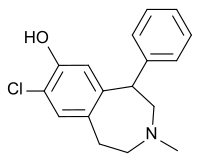SCH-23390
SCH-23390 also known as halobenzazepine, is a synthetic compound that acts as a D1 receptor antagonist and has either minimal or negligible effects on the D2 receptor.
 | |
| Names | |
|---|---|
| IUPAC name
7-chloro-3-methyl-1-phenyl-1,2,4,5-tetrahydro-3-benzazepin-8-ol | |
| Identifiers | |
3D model (JSmol) |
|
| ChEBI | |
| ChEMBL | |
PubChem CID |
|
| UNII | |
CompTox Dashboard (EPA) |
|
| |
| Properties | |
| C17H18ClNO | |
| Molar mass | 287.78 g/mol |
Except where otherwise noted, data are given for materials in their standard state (at 25 °C [77 °F], 100 kPa). | |
| Infobox references | |
In a 1990 study in rats SCH-23390 offered significant protection from death in dextroamphetamine overdosage, without providing protection from death by methamphetamine overdose. The compound provided significant protection from cocaine overdose in rats only at the lowest dose tested in the measurement series. This suggested that D-amphetamine and methamphetamine at high (lethal) doses have different mechanisms of toxicity in rats.[1]
References
- Derlet, R. W.; Albertson, T. E.; Rice, P. (1990). "The Effect of SCH 23390 Against Toxic Doses of Cocaine, d-Amphetamine and Methamphetamine". Life Sciences. 47 (9): 821–827. doi:10.1016/0024-3205(90)90555-6. PMID 2215083.
This article is issued from Wikipedia. The text is licensed under Creative Commons - Attribution - Sharealike. Additional terms may apply for the media files.